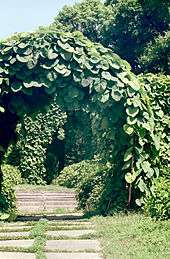Bathsheba's spring and bower

Bathsheba's spring and bower, also known as Bathsheba's bath and bower, was the name of a well-known eighteenth-century property in Philadelphia's Society Hill neighborhood and said to be the first spa of the area. It had a natural spring well with water that was considered to be of exceptional quality and to have curative properties.
Owner
Bathsheba Bauer (German), anglicized to Bathsheba Bowers, was a young lady that purchased the Second Street property around 1690 from the Free Society of Traders. It was next to a natural spring at Society Hill in Philadelphia, Pennsylvania. There she built a small house of unusual design. Bower was a recluse and considered an eccentric. Her religion was sometimes that of a Quaker and other times a mix of other religions.[1]
Description
The property had an elaborately designed garden around the house that Bower maintained.[2] It was called by many "Bathsheba's bower" and the spring was known as "Bathsheba's spring." The property at Society Hill was also known as "Bathsheba's bath and bower."[3] The spring well water was known as the best quality in the city and said to have curative properties.[4] The bower that was next to the house was surrounded with shrubbery.[5][6]
According to architect Ieoh Ming Pei, the 1700s property was set up as a business and said to be the first spa in the Society Hill area.[4] She provided a drinking cup for use by anyone to drink some of the spring water.[7] The property was located near the Benjamin Loxley house on the west side of the street where General Cadwallader constructed a large house. When others tried to construct houses near Cadwallader's they found the ground to be soft from an underground spring. They had to drive piles down into the ground to make a foundation. A local Philadelphian by the name of Alexander Fullerton, when in his mid-seventies around the year 1840, spoke of a property with a spring he remembers as a boy called "Bathsheba's spring and bower" in the Society Hill area.[7] He knew of a village pump near there that drew water from this spring source and that the quality of the water was excellent.[8][9]
References
Citations
- ↑ Petrulionis 1999, pp. 62–66.
- ↑ Stevenson 2001, p. 508.
- ↑ Watson 1881, p. 411.
- 1 2 Pei 2003, p. 26.
- ↑ Du Ponceau 1836, p. 286.
- ↑ Dennie 1824, p. 95.
- 1 2 Watson 1881, p. 412.
- ↑ "Watson's annals of Philadelphia and Pennsylvania, Vol. I / written 1830 – 1850". USGenWeb Archives. EVC. 2015. Retrieved August 1, 2015.
- ↑ Rees 1866, p. 123.
Sources
- Dennie, Joseph (1824). The Port Folio – Volumes 40–42; Volumes 220–227 of American periodical series, 1800–1850. Asbury Dickens.
- Du Ponceau, Peter Stephen (1836). The Philadelphia Book: Or, Specimens of Metropolitan Literature. Key & Biddle.
- Pei, I.M. (2003). I.M. Pei and Society Hill: a 40th Anniversary Celebration. DIANE Publishing. ISBN 0756735548.
The property belonged to Bathsheba Bauer (later garbled to Bower), who purchased it from the Free Society of Traders and set up shop as Society Hill's first spa.
- Petrulionis, Sandra Harbert (1999). "Bathsheba Bowers". Dictionary of Literary Biography: American Women Prose Writers to 1820. 200. Gale Research. ISBN 0787618551.
- Rees, James (1866). Foot-prints of a Letter Carrier; Or, A History of the World's Correspondence: Containing Biographies, Tales, Sketches, Incidents, and Statistics Connected with Postal History. J.B. Lippincott & Company,.
- Stevenson, Jane (2001). Early Modern Women Poets (1520–1700): An Anthology. Oxford University Press. ISBN 0199242577.
- Watson, John Fanning (1881). Annals of Philadelphia and Pennsylvania, in the Olden Time: Being a Collection of Memoirs, Anecdotes, and Incidents of the City and Its Inhabitants, and of the Earliest Settlements of the Inland Part of Pennsylvania, Volume 1. Applewood Books. ISBN 1429022280.